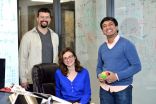Getting antibodies into shape to fight cancer
2014-12-11
(Press-News.org) Scientists at the University of Southampton have found that the precise shape of an antibody makes a big difference to how it can stimulate the body's immune system to fight cancer, paving the way for much more effective treatments.
The latest types of treatment for cancer are designed to switch on the immune system, allowing the patient's own immune cells to attack and kill cancerous cells, when normally the immune cells would lie dormant.
In a study, funded by Cancer Research UK and published in the journal Cancer Cell, the Southampton team have found that a particular form of antibody, called IgG2B, is much more effective at stimulating cancer immunity than other types. Unlike other forms of antibody, IgG2B can work independently without needing help from other immune cells, making it more active and able to work in all tissues of the body. The team have also been able to engineer antibodies that will be locked into the particular shape (called a locked B structure) that is most active, making them much stronger immune stimulators than previous drugs.
Dr Ann White, who led the study, comments: "We know that the immune system provides a natural protection against cancer, which can only grow by finding a way around our defences. Antibody treatments are now able to correct this problem for many types of cancer, but we still need them to work better.
"It is early days, but this important discovery could enable us to treat more cancers effectively. Our next task is to bring these novel IgG2B antibodies into trials for cancer patients and we are engineering ways to make them effective in the clinic."
The team is now working to discover why the IgG2 molecule works better in a locked B structure. To do this the molecule has been crystallised and an x-ray shone through it so the structure can be assessed. It is the first time that the IgG2 has been crystallised.
Professor Nic Jones, Cancer Research UK's chief scientist, said: "This research has zeroed in on how we can make immunotherapy treatments more effective against cancer. Energising the immune cells in our body and getting them to treat cancer cells as a threat gives us a better shot at beating cancer. Immunotherapy is part of the future of cancer treatment and it's important that we use our best immunotherapy weapons to fight the disease."
INFORMATION:
This latest work is one example of a wide ranging research programme into cancer immunotherapy at the University of Southampton. The team runs clinical trials and has had notable success with immunotherapy in the treatment of hard to beat cancers, specifically: skin, lung, lymphoma and pancreatic cancer, as well as the childhood cancer, neuroblastoma. The University is currently raising £20million to build a new dedicated cancer immunology research centre, which is anticipated to be open in 2016. To find out more about the campaign visit http://www.southampton.ac.uk/cancerimmunology
ELSE PRESS RELEASES FROM THIS DATE:
2014-12-11
PHILADELPHIA - (Dec. 11, 2014) - A team of scientists, led by researchers at The Wistar Institute, has found that an infection with herpes simplex virus 1 (HSV-1) causes rearrangements in telomeres, small stretches of DNA that serve as protective ends to chromosomes. The findings, which will be published in the Dec. 24 edition of the journal Cell Reports, show that this manipulation of telomeres may explain how viruses like herpes are able to successfully replicate while also revealing more about the protective role that telomeres play against other viruses.
"We know ...
2014-12-11
The saga of the Osedax "bone-eating" worms began 12 years ago, with the first discovery of these deep-sea creatures that feast on the bones of dead animals. The Osedax story grew even stranger when researchers found that the large female worms contained harems of tiny dwarf males.
In a new study published in the Dec. 11 issue of Current Biology, marine biologist Greg Rouse at Scripps Institution of Oceanography at UC San Diego and his collaborators reported a new twist to the Osedax story, revealing an evolutionary oddity unlike any other in the animal kingdom. Rouse's ...
2014-12-11
HOUSTON -- (Dec. 11, 2014) -- In a triumph for cell biology, researchers have assembled the first high-resolution, 3-D maps of entire folded genomes and found a structural basis for gene regulation -- a kind of "genomic origami" that allows the same genome to produce different types of cells. The research appears online today in Cell.
A central goal of the five-year project, which was carried out at Baylor College of Medicine, Rice University, the Broad Institute and Harvard University, was to identify the loops in the human genome. Loops form when two bits of DNA that ...
2014-12-11
BUFFALO, N.Y. -- Some drugs used to treat diabetes mimic the behavior of a hormone that a University at Buffalo psychologist has learned controls fluid intake in subjects. The finding creates new awareness for diabetics who, by the nature of their disease, are already at risk for dehydration.
Derek Daniels' paper "Endogenous Glucagon-Like Peptide-1 Reduces Drinking Behavior and Is Differentially Engaged by Water and Food Intakes in Rats," co-authored with UB psychology graduate students Naomi J. McKay and Daniela L. Galante, appears in this month's edition of the Journal ...
2014-12-11
London, United Kingdom, December 11, 2014 - Middle East respiratory syndrome coronavirus (MERS-CoV) is an emerging virus, with the first case reported in 2012. It exhibits a 40% fatality rate and over 97% of the cases have occurred in the Middle East. In three new studies in the current issue of the International Journal of Infectious Disease, researchers reported on clinical outcomes in the Kingdom of Saudi Arabia (KSA), how long patients will shed virus during their infections, and how the Sultanate of Oman is dealing with cases that have appeared there. An editorial ...
2014-12-11
(MEMPHIS, Tenn. - December 11, 2014) Toddlers who undergo total body irradiation in preparation for bone marrow transplantation are at higher risk for a decline in IQ and may be candidates for stepped up interventions to preserve intellectual functioning, St. Jude Children's Research Hospital investigators reported. The findings appear in the current issue of the Journal of Clinical Oncology.
The results clarify the risk of intellectual decline faced by children, teenagers and young adults following bone marrow transplantation. The procedure is used for treatment of cancer ...
2014-12-11
University of Rochester researchers believe they're on track to solve the mystery of weight gain - and it has nothing to do with indulging in holiday eggnog.
They discovered that a protein, Thy1, has a fundamental role in controlling whether a primitive cell decides to become a fat cell, making Thy1 a possible therapeutic target, according to a study published online this month by the FASEB Journal.
The research brings a new, biological angle to a problem that's often viewed as behavioral, said lead author Richard P. Phipps, Ph.D. In fact, some diet pills consist of ...
2014-12-11
New Rochelle, NY, December 11, 2014--In cases of traumatic brain injury (TBI), predicting the likelihood of a cranial lesion and determining the need for head computed tomography (CT) can be aided by measuring markers of bone injury in the blood. The results of a new study comparing the usefulness of two biomarkers released into the blood following a TBI are presented in Journal of Neurotrauma, a peer-reviewed journal from Mary Ann Liebert, Inc., publishers. The article is available free on the Journal of Neurotrauma website at http://online.liebertpub.com/doi/full/10.1089/neu.2013.3245 ...
2014-12-11
MAYWOOD, Il. - Riding a couple roller coasters at an amusement park appears to have triggered an unusual stroke in a 4-year-old boy, according to a report in the journal Pediatric Neurology.
The sudden acceleration, deceleration and rotational forces on the head and neck likely caused a tear in the boy's carotid artery. This tear, called a dissection, led to formation of a blood clot that triggered the stroke, Loyola University Medical Center neurologist Jose Biller, MD and colleagues report.
Strokes previously have been reported in adult roller coaster riders, but ...
2014-12-11
Worcester, Mass. - A new statistical model developed by a research team at Worcester Polytechnic Institute (WPI) may enable physicians to create personalized cancer treatments for patients based on the specific genetic mutations found in their tumors.
Just as cancer is not a single disease, but a collection of many diseases, an individual tumor is not likely to be comprised of just one type of cancer cell. In fact, the genetic mutations that lead to cancer in the first place also often result in tumors with a mix of cancer cell subtypes.
The WPI team developed a new ...
LAST 30 PRESS RELEASES:
[Press-News.org] Getting antibodies into shape to fight cancer



